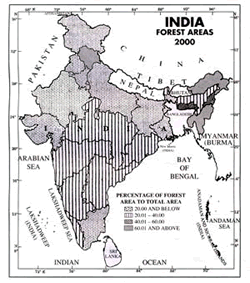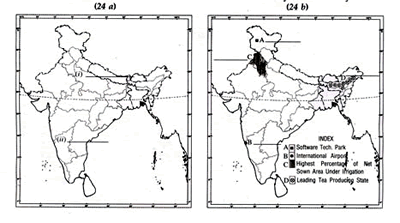Q.1. Describe the contribution of M.G.Ranade to Indian awakening. (2)
Q.2. Explain any two positive impacts of British rule in the modernization of India. (2 x 1 = 2)
Q.3. Study the map given below showing distribution of forests in India and answer the questions that follow:

(3.1) Name any two north-eastern States having more than 60 per cent of their area under States of India.(1)
(3.2) Why do these States have larger area under forest cover? Give two reasons.(1)
Q.4. Indian culture represents ‘Unity in Diversity’. Explain this statement with two examples. (2 x 1 = 2)
Q.5. Mention two religious movements that grew in Medieval India under the influence of Islam. (2 x 1 = 2)
Q.6. Explain with examples any two types of homes that should be built in the earthquake prone areas. (2 x 1 = 2)
Q.7. Examine the role of ‘Indian Armed Forces’ in disaster management. (2)
Q.8. What is meant by economic growth in an economy? Give two points. (2 x 1 = 2)
Q.9. Distinguish between Wholesale Price Index and Consumer Price Index. (2)
Q.10. “Human development is an essence of social development.” Justify this statement with two arguments. (2 x 1 = 2)
Q.11. Examine the main functions of the ‘Disaster Management Committee’ at the Block level. (2)
Q.12. “The district administration is the focal point for implementation of all Government plans and activities.” Support the statement with two examples. (2 x 1 = 2)
Q.13. In what way was the British rule detrimental to the interest of all the sections of the Indian society? Explain with examples. (4)
Or
Examine any four common features of all the reform movements, on which they laid stress.
Q.14. Describe any four features of Indian agriculture. (4 x 1 = 4 )
Or
Describe any four points of importance of animal husbandry in rural development of India.
Q.15. Describe any four methods which can be used to conserve mineral resources in India. (4 x 1 = 4)
Q.16. When is the ‘United Nations Day’ celebrated? Name the six organs of the United Nations. (1 + 3 = 4)
Q.17. Explain four major problems faced by cotton textile industry in India. (4 x 1 = 4)
Q.18. What is meant by communication? Differentiate between personal communication and mass communication. (1 + 3 = 4)
Q.19. Mention any four causes of rural poverty. How is the Government of India trying to reduce the gap between the rich and the poor? (2 + 2 = 4)
Q.20. Explain how the fiscal measures and the Public Distribution System help in controlling price rise. (4)
Or
Explain the importance of consumer awareness in protecting the interests of consumers.
Q.21. Examine the factors responsible for the emergence of extremism in the Indian National Movement. (6)
Or
Explain the impact of communalism in the Indian National Movement.
Q.22. Define the term ‘Multipurpose River Valley Project’. State any five objectives of Multipurpose River Valley Projects. (1 + 5 = 6)
Or
Define the term ‘Rain Water Harvesting’. State any five objectives of rain water harvesting.
Q.23. Give the main effect of casteism. Suggest suitable measures for eradicating the evils of casteism. What has been done in the Constitution to curb ills of casteism? (1 + 2 + 3 = 6)
Or
Explain any six measures which have been taken by the Indian Government towards the welfare of the Scheduled Castes and Scheduled Tribes. (6 x 1 = 6)
Q.24.
Or
On the given political outline map of India (24 b) locate and label the following and attach the map in your answer book.

Note: The following question is for the blind candidates only in lieu of Q. No. 24(a and b).
(24.1) Name the city where Qutub Minar is situated.
(24.2) Name the state where the buildings of Hampi are situated.
(24.3) Name the Software Technology Park in Jammu and Kashmir.
(24.4) Name the International Airport of Goa.
(24.5) Name the two states having the highest percentage of net sown area under irrigation.
(24.6) Name the oil refinery located in Assam.